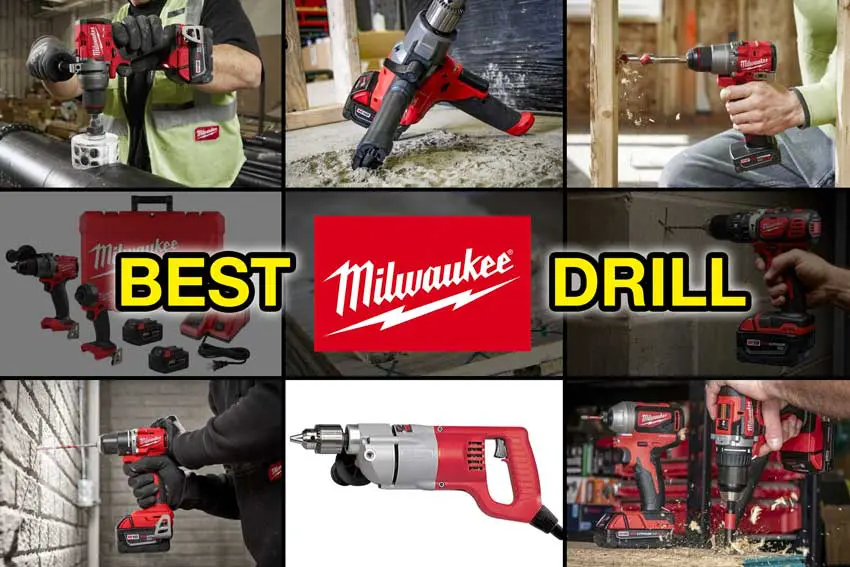Milwaukee Tool makes a ton of drills. Between 12V and 18V, brushed and brushless, corded and cordless—you have a lot to choose from. So how do you pick? When you put your hands on and test over 50 drills a year, you get a feel for who makes the best cordless drill. This article helps you understand how each of the Milwaukee cordless drills fits into their lineup. The best Milwaukee drill for you may be the most powerful, the best value, or the most compact. It just depends on what you plan to do with the tool and what kind of work you want to accomplish.
My recommendations come after hours of torque and run-time testing and after giving the tools lots of real-world use. I recommend a different Milwaukee drill for the journeyman electrician than I do for someone just starting out in construction. Yet another drill makes sense for the homeowner who wants to use Milwaukee tools. Recommending a single tool for everyone never works. Hopefully, I can help you find the model that gives you the performance, features, ergonomics, and value you need.
Best Milwaukee Drills – My Top Picks
- Best Overall: M18 FUEL 2904 Hammer Drill – Buy from Acme Tools
Jump to this Drill ↓ - Best 12V: M12 FUEL 3404 Hammer Drill – Buy from Acme Tools
Jump to this Drill ↓ - Best Corded: 5378-20 Pistol Grip – Find a Dealer
Jump to this Drill ↓ - Best 18V Compact: M18 3602 Compact Brushless – Buy from Acme Tools
Jump to this Drill ↓ - Best for the Money: M18 2801 Compact Brushless – Buy from Acme Tools
Jump to this Drill ↓ - Best for Mixing: M18 FUEL 2810 Mud Mixer Drill – Buy from Acme Tools
Jump to this Drill ↓
Also in this Article
- Best Milwaukee Drill Sets
- Best Milwaukee Drill Bits
- Milwaukee Drill and Hammer Drill Buying Guide
- How We Test Drills and Hammer Drills
- Why You Can Trust Pro Tool Reviews
Best Milwaukee Drill Overall
Milwaukee M18 FUEL 2904 Hammer Drill with AutoStop
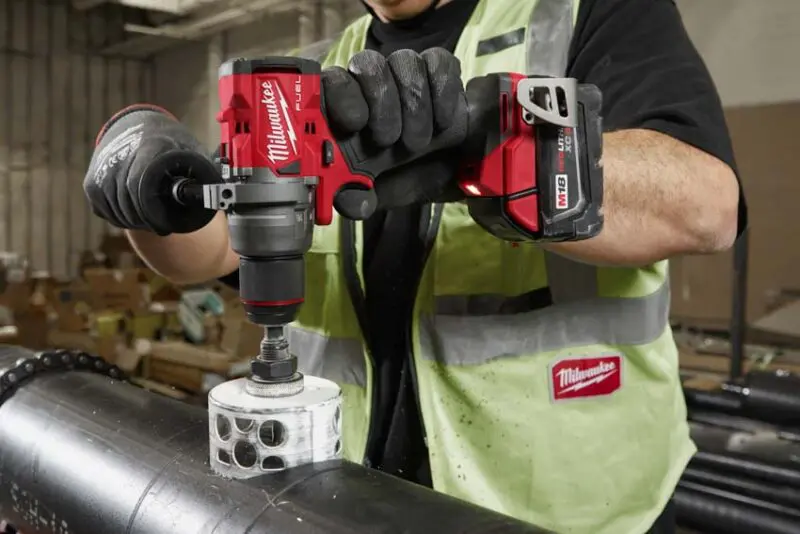
Pros
- The most powerful and capable Milwaukee drill
- Autostop protection against over-rotation
- Available with or without Milwaukee One-Key
Cons
- The most expensive Milwaukee hammer drill
Based on our testing, the 4th-generation Milwaukee 2904 hammer drill steals the show for the best Milwaukee drill overall. My pick comes as a result of several factors. First, it saves $50 over the 2906 with Milwaukee ONE-KEY technology. If you want One-Key, you can certainly grab the more expensive model.
The Milwaukee 2904-20 brushless hammer drill has 1,400 inch-pounds of torque. More importantly, however, it optimizes that torque for speed. This is one of only a few drills that can drive a 2-9/16″ wood boring bit at High speed. That means you gain some serious productivity during rough-ins. It also now features AutoStop technology. That stops the drill during a bind-up event before it damages your wrist.
Expect to pay around $299 for the kit. Lastly, I also like the 5-year warranty—which you’ll see on all my recommended Milwaukee drills.
Best Milwaukee 12V Drill
Milwaukee M12 FUEL 3404 Hammer Drill

Pros
- The most powerful and capable Milwaukee 12V (M12) drill
- Excellent power-to-weight
- Most torque in ANY 12V drill
Cons
- Expensive hammer drill option
I honestly love that Milwaukee has a solid 12V offering in this category. With that said, I have two great recommendations depending on the power requirements and applications you have in mind.
Starting small and working up, I find the Milwaukee M12 FUEL 3404 hammer drill hard to top. This M12 series hammer drill offers tons of power for its size. Milwaukee released this 3rd-generation tool in 2022, making it even more compact while not sacrificing any power. I tested this tool which puts out 400 in-lbs of torque vs the 350 in-lbs of the 2nd-gen 2504. I also like that Milwaukee Tool continued with the handy belt clip design.
If you want enough power to tackle up to 1/4-inch holes in block or brick, but don’t plan on spending all day with your drill, this M12 series tool saves some serious weight. I know several MRO, HVAC, and electrical Pros who choose this line for their primary tools. At $179 for the 2-battery kit, you get a lot of power in a compact package.
Best Milwaukee Corded Drill
Milwaukee 1107-6 Corded 1/2-in D-Handle Drill

Pros
- Endless power and unlimited runtime
- Great for drilling horizontally in steel
- Available with a right-angle attachment
- Quik-Lok power cord
Cons
- Heavy 6.8 lbs. tool
- It’s corded!
If you need a corded drill—perhaps for repetitive steel drilling, the Milwaukee 1107-6 corded 1/2″ D-handle drill. This 7A tool provides up to 500 RPM and can easily handle up to 1/2-inch holes in steel.
One thing that frustrates those still using corded tools is broken power cords. With the Quik-Lok system, the cord can easily detach from the tool, letting you replace it as needed in the field. This drill costs around $242; you can find it with a right angle attachment as the 3107-6 for around $349.
Best Compact Milwaukee Drill
Milwaukee M18 3602 Compact Brushless

Pros
- Plenty of torque for much less than their flagship M18 model
- Weighs just 2.3 pounds!
- Only 5.8 inches from back to tip of the chuck
Cons
- None at this price
The idea of a compact drill centers around having a reliable tool that can do 80% of the work of a flagship product. Along the way, you save some weight—and certainly some money. With that definition, I heartily recommend the Milwaukee M18 compact brushless 1/2-inch hammer drill.
Positioned in the middle of the drill and hammer drill lineup, the 3602 delivers up to 550 in-lbs of torque and 1700 RPM. The 1/2-inch metal chuck still delivers the expected Milwaukee quality and the brushless motor gives you excellent runtime and durability.
If you don’t need—and don’t want to pay for—the absolute best Milwaukee offers, you can get a ton of value and performance from this hammer drill. It may be all you need if you work in the MEP, MRO, and similar disciplines. Grab the tool for just $149 or the kit for $219.
Best Milwaukee Drill for the Money (and Homeowners)
Milwaukee 2494-22 M12 Drill/Impact Combo Kit

Pros
- Best value drill/impact driver kit you will find
- 275 in-lbs torque in the drill
- 1,000 in-lbs torque in the impact driver
Cons
- None at this price!
Sometimes you don’t need the maximum amount of power. If saving money without sacrificing quality makes sense to you, check out the Milwaukee 2494-22 drill/impact driver kit. This kit gives you a twofer, netting you both drilling and driving capabilities for less than $120. For homeowners, you get enough power, runtime, and speed to tackle most household applications. It also costs significantly less than a single flagship M18 FUEL drill kit—and you get two great tools.
Aside from the $119 kit price, I named this my best Milwaukee drill for the money primarily because of its immense value. One of the most compact drills in the Milwaukee M12 lineup, it also includes that impact driver for more flexibility and capabilities. While it features a brushed motor, you still get great performance, a full metal chuck, and tools that weigh around 2 pounds before you add one of the included 1.5 Ah batteries.
Best Milwaukee Drill for Mixing Concrete or Paint
Milwaukee M18 FUEL 2810 Mud Mixer
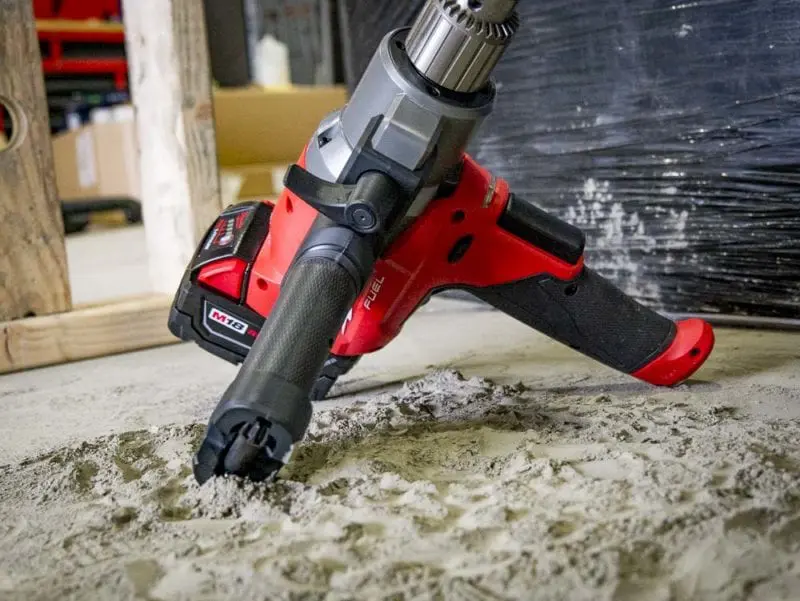
Pros
- Plenty of power
- Wide range of speed for mixing applications
- Configurable handle for multiple grips
- Keyed 1/2-inch chuck works with any mixing paddles
Cons
- None at this price
While many of the newest flagship cordless drills can handle some mixing tasks, I still use a dedicated mixing drill. The best Milwaukee drill for mixing is the 2810 M18 FUEL mud mixer. This tool runs just $219 and delivers the power needed to mix tough materials including concrete and mortar. Paint? Merely a trifle!
With a top speed of 550 RPM, this mixer can mix up to fifteen 5-gallon buckets on a single 5Ah RedLithium battery. Cut the cord and save your standard drill—pick up this tool if you frequently mix materials.
Best Milwaukee Drill Sets
Milwaukee tools are often best bought as kits. For the most part, I find that the batteries become much more affordable when you get them with some tools. As such, the best Milwaukee drill set could fall into the M12 or M18 category depending on what you need. I also see a difference between a simple 2-tool kit and what I define as a “starter” kit that includes enough tools to launch your career (or perhaps even switch platforms!).
18V: Milwaukee 3697-22 M18 FUEL Combo Kit
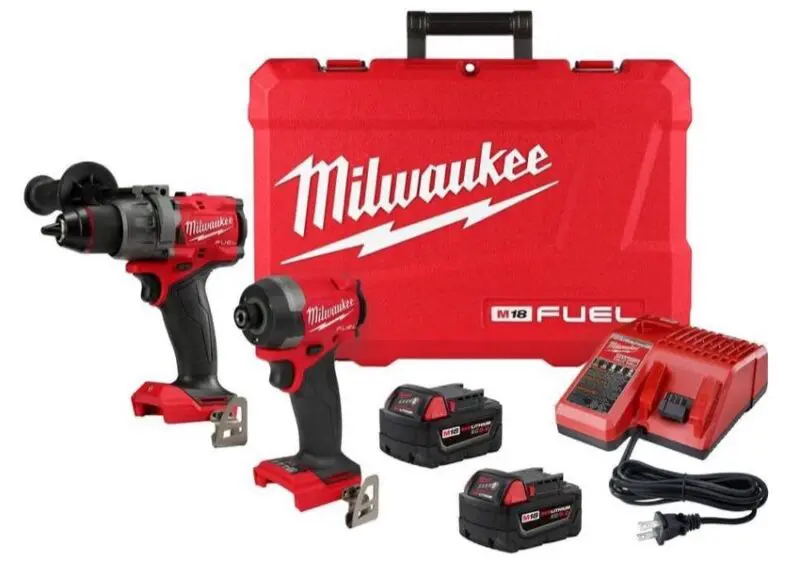
The Milwaukee 3697-22 M18 FUEL combo kit makes for such a great deal I can’t recommend it enough. This 2-tool kit includes the latest Gen4 M18 Fuel hammer drill and Milwaukee M18 impact driver. It also tosses in a pair of XC5.0 Ah battery packs and an M18/M12 Rapid Charger.
These tools have everything except One-Key, but for most Pros, I think the blend of power and compactness matters most. For around $399 for the kit, you can spend less, but electricians, plumbers, and general contractors should find it a great value. The 5-year tool warranty also helps seal the deal.
12V: Milwaukee 3497-22 M12 FUEL 2-Tool Combo Kit

I chose the 3497-22 M12 FUEL 2-tool combo kit as our best Milwaukee M12 drill kit. For starters, you can get larger kits—but they all have flaws. Some larger kits toss in a mediocre LED light that drives up the cost while the largest kits add tools you may not need.
For around $229, this core tool kit gives you exactly what you need to get started. It pairs the latest 3404-20 Gen 3 hammer drill with the excellent 3453-20 Gen 3 impact driver. I hope to eventually see this kit in a Milwaukee Packout case.
Best Expanded Milwaukee M18 Drill Kit

Unlike the M12 2-tool kit above, I have different thoughts about the best Milwaukee M18 drill kits. The reason has to do with the application. For many Pros starting out, they need to ramp up their system quickly. I see no better way than to purchase a comprehensive Milwaukee starter tool kit. It won’t be cheap, but it gets you up to speed quickly with the tools of the trade.
My favorite kit is the M18 6-tool combo kit (2696-26). It includes a suite of solid M18 starter tools. You get a hammer drill, impact driver, Full-size Sawzall, 6-1/2-inch circular saw, angle grinder, and LED work light. The price is no joke at $749, but you won’t need much else (except maybe a mid-torque impact wrench) to get up and running. Need more power? You can easily upgrade any of these tools over time to their M18 FUEL counterparts.
Best Milwaukee Drill Bits
A drill doesn’t do much good without the proper bits. I can make some recommendations on the best Milwaukee drill bits, but it really depends on the material you intend to drill.
Best Milwaukee Drill Bits for Wood

For wood drilling, I like the Milwaukee Shockwave Titanium Nitride bits. The titanium coats these bits to reduce friction. The advantage is they fly through wood. The downside is you eventually wear away the coating and don’t benefit (as much) from sharpening these when they go dull. These bits also feature a hex shank to use with an impact driver.
Best Milwaukee Drills Bits for Steel
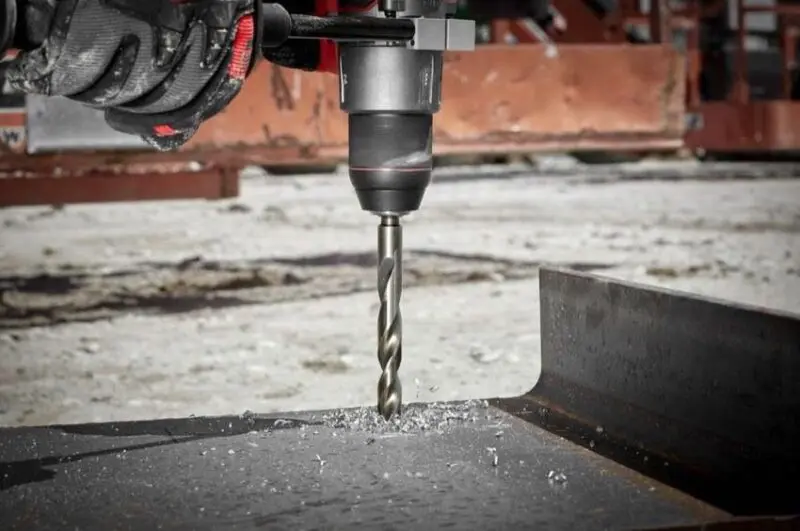
For drilling in harder metals, check out the Milwaukee Red Helix Cobalt Drill Bits. These bits drill faster than standard 135° split point cobalt bits and feature a Quadedge Tip that reduces heat. Since you can sharpen these bits, they can last a good long time. We LOVE these bits…but hate the case they come in (they are a tad difficult to remove).
Milwaukee Cordless Drill Buying Guide – What I Look For
Performance
Performance is my top priority when evaluating drills. Pro Tool Reviews tests in various materials, including concrete, wood, and metal, to gauge a drill’s performance in light and heavy-duty tasks. However, every drill isn’t tested for every possible task, as some drills are not suitable for certain jobs.
Additionally, the PTR Drill Test Track simulates real-world conditions and assesses a drill’s control and ability to handle medium and heavy loads. The test concludes when the drill completes the final, heavy-load task, taking into account any bit changes or human errors.
Size and Weight
I generally prefer the most compact and lightweight drills possible. They are easier to maneuver in tight spaces and they cause less fatigue when working overhead. I prefer the smallest and lightest drill that can effectively complete a task. If a drill weighing 4 pounds represents 100% power and a second drill weighs 3 pounds with 90% of that power, I’ll take door #2 every time.
Ergonomics
Additionally, the ergonomics and handle design of a drill can greatly impact user comfort, and it’s a good idea to try holding different drills in-store to find the one that feels best for you. Most of us prefer certain brands’ handles over others. My advice? See what works best for you.
Features to Look For
Today, drills include many features—some of which I find very helpful. While not all features are necessary, some can help you complete jobs much more quickly. I typically look for the following:
- Anti-Kickback feature: stops the motor if the bit binds up
- Brushless motor: Almost all drills include brushless motors vs brushed now. A brushless motor provides longer runtime, better performance, and longer motor life
- Interchangeable chucks: switching to a specialized chuck can get you out of a sticky situation
- All-metal chuck: better durability
- LED light: nearly every drill has one, but my favorites put the light(s) around the chuck
- More than 2 speeds: While 2 speeds are a must, more often speeds up your work because you can get a bit more speed when tackling higher torque applications
- Belt hook: usually reversible, they’re super-helpful when you have materials to carry or you’re climbing a ladder
- Nice-to-have: Smart controls: helps with inventory management and tracking, some offer customizable controls
Price and Value
When buying a cordless drill, consider your budget and try to get the most value for your money. Additionally, look for compatibility with other tools, a longer warranty, and a convenient service center. Consider where you will get new batteries or expand your tool collection. For professionals, having a good dealer relationship can be beneficial.
Why Milwaukee Cordless Drills?
The best cordless drills, like those from Milwaukee Tool, are essential tools for both professionals and homeowners. These versatile tools let you drill holes in a variety of materials like wood, metal, composite, and even drywall. You can use them to hang pictures, run wiring and plumbing, create pilot holes, and complete other projects.
The best Milwaukee cordless drills now include additional features such as AutoStop kickback control to protect you against bind-ups. I like their solid clutch settings that help when driving screws into softer materials. Their hammer drills do really well—even in harder materials like concrete and brick. Cordless drills allow for greater mobility and flexibility to work on different projects without the need for a power cord. They’re all but ubiquitous at this point.
How We Test Milwaukee (and Other) Drills
Speed Testing Under Load
To check the drilling speed of each tool, Pro Tool Reviews puts them through a series of relevant tests at both high and low speeds. Timed tests help us measure the RPM of a bit under load. This reveals how much of its no-load speed it maintains when truly engaged. The higher the RPMs a drill maintains, the faster the bit moves through the material.
The real-world application for this test uses a timed test with a tough application, like driving long ledger screws into stacked OSB. We also test soft torque using an inline torque meter while driving 1/2-inch lag bolts into wood.
Matching the Accessory to the Power Tool
Each class of drill has a different amount of muscle. You shouldn’t expect a compact drill to do what a heavy-duty one can. Pro Tool Reviews ensures each bit type and size are within the design intent of the drill being tested. That means smaller self-feed and spade bits for tools not rated the same as flagship models. We also vary the type of fasteners we drive depending on the type of drill.
Torque Testing
Several tools let us test torque. With drills, an inline torque device measures the maximum soft torque a drill can produce when driving a 1/2-inch lag bolt into laminated OSB. Hands-on testing lets us evaluate the drills in multiple gears to determine which models produce the most torque at higher speeds.
Weight
Using a digital scale, the weight of the bare tool is measured along with the tool with the kitted battery installed. Occasionally, a measurement is taken with a premium battery for comparison.
Footprint
Using a digital caliper, Pro Tool Reviews measures the head length and tool height without a battery installed.
Grip
The comfort of each drill’s grip is subjective based on size and does not affect the score. I hold and use each tool with a bare hand to see if there are any uncomfortable seams or other oddities that might affect every user regardless of preferences.
Feature Set
In general, here are the features I look for on each drill:
- Brushless or brushed motor
- Number of standard modes
- Anti-kickback features
- Smart controls
- Smart tracking/inventory
- Clutch design
- Drill/driver/hammer drill selection design
- LED light design
- Chuck size/type
- Belt hook
- Additional unique features
Value
Value is more than just the price of the tool. I consider the whole picture of what you get for the price you pay. That includes the performance, feature set, ergonomics, warranty, bare tool price, and kit price.
Why You Can Trust Pro Tool Reviews
Ever check out a “review” site and you can’t tell if they actually tested the tools or if they’re just “recommending” the Amazon top sellers?
That’s not us. We only recommend what we’d actually use, even if we don’t earn a commission from it. It’s all about giving you a legitimate recommendation and our honest opinion of each product.
We’ve been in business since 2008 covering tools, writing reviews, and reporting on industry news in the construction, automotive, and lawn care industries. Our Pro reviewers work in the trades and have the skills and experience to know whether tools can perform well in the field.
Each year, we bring in and review more than 250 individual products. Our team will put our hands on hundreds of additional tools at media events and trade shows throughout the year.
We consult with innovators in the technology and design of tools to gain a broader grasp of where these products fit and how they work.
We work with more than two dozen professional contractors around the United States who review products for us on real jobsites and consult with us on testing methods, categories, and weighting.
We’ll provide more than 500 pieces of new content this year free for our readers—including objective evaluations of individual tools and products.
The result is information you can trust because of the editorial, scientific, and real-world professional experience we collectively utilize every time we pick up and test a tool.

